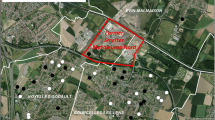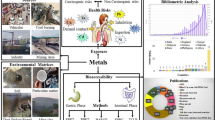Abstract
Metal smelting is often responsible for local contamination of environmental compartments. Dust materials escaping from the smelting facilities not only settle in the soil, but can also have direct effects on populations living close to these operations (by ingestion or inhalation). In this particular study, we investigate dusts from Cu–Co metal smelters in the Zambian Copperbelt, using a combination of mineralogical techniques (XRD, SEM/EDS, and TEM/EDS), in order to understand the solid speciation of the contaminants, as well as their bioaccessibility using in vitro tests in simulated gastric and lung fluids to assess the exposure risk for humans. The leaching of metals was mainly dependent on the contaminant mineralogy. Based on our results, a potential risk can be recognized, particularly from ingestion of the dust, with bioaccessible fractions ranging from 21 to 89 % of the total contaminant concentrations. In contrast, relatively low bioaccessible fractions were observed for simulated lung fluid extracts, with values ranging from 0.01 % (Pb) up to 16.5 % (Co) of total contaminant concentrations. Daily intakes via oral exposure, calculated for an adult (70 kg, ingestion rate 50 mg dust per day), slightly exceeded the tolerable daily intake limits for Co (1.66× for fly ash and 1.19× for slag dust) and occasionally also for Pb (1.49×, fly ash) and As (1.64×, electrostatic precipitator dust). Cobalt has been suggested as the most important pollutant, and the direct pathways of the population’s exposures to dust particles in the industrial parts of the Zambian Copperbelt should be further studied in interdisciplinary investigations.




Similar content being viewed by others
References
Asgharian, B., Hofmann, W., & Miller, F. J. (2001). Mucociliary clearance of insoluble particles from the tracheobronchial airways of the human lung. Journal of Aerosol Science, 32, 817–832.
Baars, A. J., Theelen, R. M. C., Janssen, P. J. C. M., Hesse, J. M., van Apeldoorn, M. E., Meijerink, M. C. M., et al. (2001). Re-evaluation of human-toxicological maximum permissible risk levels. RIVM report 711701025, Bilthoven, The Netherlands.
Banza, C. L. N., Nawrot, T. S., Haufroid, V., Decrée, S., De Putter, T., Smolders, E., et al. (2009). High human exposure to cobalt and other metals in Katanga, a mining area of the Democratic Republic of Congo. Environmental Research, 109, 745–752.
Berlinger, B., Ellingsen, D. G., Náray, M., Záray, G., & Thomassen, Y. (2008). A study of bio-accessibility of welding fumes. Journal of Environmental Monitoring, 10, 1448–1453.
Bierkens, J., Van Holderbeke, M., Cornelis, C., & Torfs, R. (2011). Exposure through soil and dust ingestion. In F. A. Swartjes (Ed.), Dealing with contaminated sites (pp. 261–286). Berlin: Springer.
Bosso, S. T., & Enzweiler, J. (2008). Bioaccessible lead in soils, slags, and mine waste from an abandoned mining district in Brazil. Environmental Geochemistry and Health, 30, 219–229.
Caboche, J., Perdrix, E., Malet, B., & Alleman, L. Y. (2011). Development of an in vitro method to estimate lung bioaccessibility of metals from atmospheric particles. Journal of Environmental Monitoring, 13, 621–630.
Castillo, S., de la Rosa, J. D., de la Campa, A. M. S., González-Castanedo, Y., Fernández-Caliani, J. C., Gonzalez, I., et al. (2013). Contribution of mine wastes to atmospheric metal deposition in the surrounding area of an abandoned heavily polluted mining district (Rio Tinto mines, Spain). Science of the Total Environment, 449, 363–372.
Csavina, J., Field, J., Taylor, M. P., Gao, S., Landázuli, A., Betterton, E. A., et al. (2012). A review on the importance of metals and metalloids in atmospheric dust and aerosol from mining operations. Science of the Total Environment, 433, 58–73.
Denys, S., Caboche, J., Tack, K., Rychen, G., Wragg, J., Cave, M., et al. (2012). In vivo validation of the Unified BARGE Method to assess the bioaccessibility of arsenic, antimony, cadmium, and lead in soils. Environmental Science and Technology, 46, 6252–6260.
Deshommes, E., Tardif, R., Edwards, M., Sauvé, S., & Prévost, M. (2012). Experimental determination of oral bioavailability and bioaccessibility of lead particles. Chemistry Central Journal, 6, 138.
Drysdale, M., Bjorklund, K. L., Jamieson, H. E., Weinstein, P., Cook, A., & Watkins, R. T. (2012). Calculating the respiratory bioaccessibility of nickel in soil through the use of simulated lung fluid. Environmental Geochemistry and Health, 34, 279–288.
EC. (1999). Council directive of 1999/30/EC of 22 April 1999 relating to limit values for sulphur dioxide, nitrogen dioxide and oxides of nitrogen, particulate matter and lead in ambient air. Official Journal of the European Communities, L163, 41–60.
Ettler, V., Johan, Z., Kříbek, B., Šebek, O., & Mihaljevič, M. (2009). Mineralogy and environmental stability of slags from the Tsumeb smelter, Namibia. Applied Geochemistry, 24, 1–15.
Ettler, V., Konečný, L., Kovářová, L., Mihaljevič, M., Šebek, O., Kříbek, B., et al. (2014). Surprisingly contrasting metal distribution and fractionation patterns in copper smelter-affected tropical soils in forested and grassland areas (Mufulira, Zambian Copperbelt). Science of the Total Environment, 473–474, 117–124.
Ettler, V., Kříbek, B., Majer, V., Knésl, I., & Mihaljevič, M. (2012). Differences in the bioaccessibility of metals/metalloids in soils from mining and smelting areas (Copperbelt, Zambia). Journal of Geochemical Exploration, 113, 68–75.
Ettler, V., Mihaljevič, M., Kříbek, B., Majer, V., & Šebek, O. (2011). Tracing the spatial distribution and mobility of metal/metalloid contaminants in Oxisols in the vicinity of the Nkana copper smelter, Copperbelt province, Zambia. Geoderma, 164, 73–84.
Gál, J., Hursthouse, A., Tatner, P., Stewart, F., & Welton, R. (2008). Cobalt and secondary poisoning in the terrestrial food chain: Data review and research gaps to support risk assessment. Environment International, 34, 821–838.
Gbefa, B. K., Entwistle, J. A., & Dean, J. R. (2011). Oral bioaccessibility of metals in an urban catchment, Newcastle upon Tyne. Environmental Geochemistry and Health, 33, 167–181.
Hursthouse, A., & Kowalczyk, G. (2009). Transport and dynamics of toxic pollutants in the natural environment and their effect on human health: Research gaps and challenge. Environmental Science and Technology, 31, 165–187.
ICDD. (2003). PDF-2 database, release 2003. Newton Square, PA: International Centre for Diffraction Data.
Kříbek, B., Majer, V., Veselovský, F., & Nyambe, I. (2010). Discrimination of lithogenic and anthropogenic sources of metals and sulphur in soils of the central-northern part of the Zambian Copperbelt Mining District: A topsoil vs. subsurface soil concept. Journal of Geochemical Exploration, 104, 69–89.
Kutalek, R., Wewalka, G., Gundacker, C., Auer, H., Wilson, J., Haluza, D., et al. (2010). Geophagy and potential health implications: Geohelminths, microbes and heavy metals. Transactions of the Royal Society of Tropical Medicine and Hygiene, 104, 787–795.
Lábár, J. L. (2005). Consistent indexing of a (set of) SAED pattern(s) with the Process Diffraction program. Ultramicroscopy, 103, 237–249.
Momoh, A., Davies, T., Akinsola, H., Akinyemi, S. A., Mhlongo, S., Gitari, W., et al. (2013). Human bioaccessibility of Fe, Mn, Zn and Cu from consumed earth materials in Vhembe District, South Africa. Transactions of the Royal Society of South Africa, 68, 33–39.
Morrison, A. L., & Gulson, B. L. (2007). Preliminary findings of chemistry and bioaccessibility in base metal smelter slags. Science of the Total Environment, 382, 30–42.
Nikolić, D., Milošević, N., Mihajlović, I., Živković, Ž., Tasić, V., Kovačević, R., et al. (2010). Multi-criteria analysis of air pollution with SO2 and PM10 in urban area around the copper smelter in Bor, Serbia. Water, Air, and Soil pollution, 206, 369–383.
Ojelede, M. E., Annegarn, H. J., & Kneen, M. A. (2012). Evaluation of aeolian emissions from gold mine tailings on the Witwatersrand. Aeolian Research, 3, 477–486.
Okorie, A., Entwistle, J., & Dean, J. R. (2012). Estimation of daily intake of potentially toxic elements from urban street dust and the role of oral bioaccessibility testing. Chemosphere, 86, 460–467.
Oomen, A. G., Hack, A., Minekus, M., Zeijdner, E., Cornelis, C., Verstaete, W., et al. (2002). Comparison of five in vitro digestion models to study the bioaccessibility of soil contaminants. Environmental Science and Technology, 36, 3326–3334.
Oomen, A. G., Janssen, P. J. C. M., Dusseldorp, A., & Noorlander, C. W. (2008). Exposure to chemicals via house dust. RIVM Report 609021064, Bilthoven, the Netherlands.
Pelfrêne, A., Waterlot, C., Mazzuca, M., Nisse, C., Bidar, G., & Douay, F. (2011). Assessing Cd, Pb, Zn human bioaccessibility in smelter-contaminated agricultural topsoils (northern France). Environmental Geochemistry and Health, 33, 477–493.
Reis, A. P., Patinha, C., Noack, Y., Robert S., Dias, A. C., & Ferreira da Silva, E. (2014). Assessing the human health risk for aluminium, zinc and lead in outdoor dusts collected in recreational sites used by children at an industrial area in the western part of the Bassin Minier de Provence, France. Journal of African Earth Sciences. doi:10.1016/j.afrearsci.2013.08.001.
Ruby, M. V., Davis, A., Link, T. E., Schoof, R., Chaney, R. L., Freeman, G. B., et al. (1993). Development of an in vitro screening test to evaluate the in vivo bioaccessibility of ingested mine-waste lead. Environmental Science and Technology, 27, 2870–2877.
Ruby, M. V., Davis, A., Schoof, R., Eberle, S., & Sellstone, C. M. (1996). Estimation of lead and arsenic bioavailability using a physiologically based extraction test. Environmental Science and Technology, 30, 422–430.
Schreck, E., Foucault, Y., Sarret, G., Sobanska, S., Cécillon, L., Cestrec-Rouelle, M., et al. (2012). Metal and metalloid foliar uptake by various plant species exposed to atmospheric industrial fallout: Mechanisms involved for lead. Science of the Total Environment, 427–428, 253–262.
Swartjes, F. A. (2002). Variation in calculated human exposure. Comparison of calculations with seven European human exposure models. RIVM report 711701030, Bilthoven, the Netherlands.
Swartjes, F. A., & Cornelis, C. (2011). Human health risk assessment. In F. A. Swartjes (Ed.), Dealing with contaminated sites (pp. 209–259). Berlin: Springer.
Twining, J., McGlinn, P., Loi, E., Smith, K., & Gieré, R. (2005). Risk ranking of bioaccessible metals from fly ash dissolved in simulated lung and gut fluids. Environmental Science and Technology, 39, 7749–7756.
US EPA. (2007). Estimation of relative bioavailability of lead in soil and soil-like materials using in vivo and in vitro methods. Office of Solid Waste and Emergency Response. OSWER 9285 (pp. 7–77). Washington, DC: US EPA.
US EPA. (2011a). National ambient air quality standards (NAAQS). Washington, DC: US EPA. http://www.epa.gov/air/criteria.html.
US EPA. (2011b). Glossary of key terms. Washington, DC: US EPA. http://www.epa.gov/nata/gloss1.html.
US EPA. (2011c). Exposure factors handbook (EFH). Washington, DC: US EPA. EPA/600/R-09/052F.
Uzu, G., Sobanska, S., Sarret, G., Sauvain, J. J., Pradère, P., & Dumat, C. (2011). Characterization of lead-recycling facility emissions at various workplaces: Major insights for sanitary risks assessment. Journal of Hazardous Materials, 186, 1018–1027.
Vítková, M., Ettler, V., Hyks, J., Astrup, T., & Kříbek, B. (2011a). Leaching of metals from copper smelter flue dust (Mufulira, Zambian Copperbelt). Applied Geochemistry, 26, S263–S266.
Vítková, M., Ettler, V., Johan, Z., Kříbek, B., Šebek, O., & Mihaljevič, M. (2010). Primary and secondary phases in copper-cobalt smelting slags from the Copperbelt Province, Zambia. Mineralogical Magazine, 74, 581–600.
Vítková, M., Ettler, V., Mihaljevič, M., & Šebek, O. (2011b). Effect of sample preparation on contaminant leaching from copper smelting slag. Journal of Hazardous Materials, 197, 417–423.
Vítková, M., Hyks, J., Ettler, V., & Astrup, T. (2013). Stability and leaching of cobalt smelter fly ash. Applied Geochemistry, 29, 117–125.
Wragg, J., Cave, M., Basta, N., Brandon, E., Casteel, S., Denys, S., et al. (2011). An inter-laboratory trial of the unified BARGE bioaccessibility method for arsenic, cadmium and lead in soil. Science of the Total Environment, 409, 4016–4030.
Acknowledgments
This study was supported by the Czech Science Foundation (GAČR 210/12/1413 and 13-17501S), and the Ministry of Education, Youth and Sports of the Czech Republic (MSM 0021620855) and was carried out within the framework of IGCP Project No. 594 (“Assessment of impact of mining and mineral processing on the environment and human health in Africa”). Peter Lemkin and Madeleine Štulíková are thanked for review of the English in the manuscript.
Author information
Authors and Affiliations
Corresponding author
Electronic supplementary material
Below is the link to the electronic supplementary material.
Rights and permissions
About this article
Cite this article
Ettler, V., Vítková, M., Mihaljevič, M. et al. Dust from Zambian smelters: mineralogy and contaminant bioaccessibility. Environ Geochem Health 36, 919–933 (2014). https://doi.org/10.1007/s10653-014-9609-4
Received:
Accepted:
Published:
Issue Date:
DOI: https://doi.org/10.1007/s10653-014-9609-4




